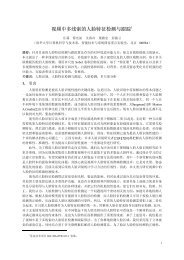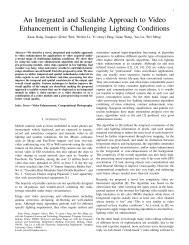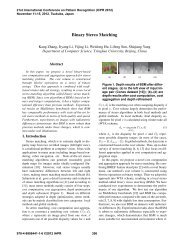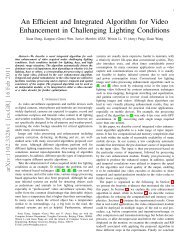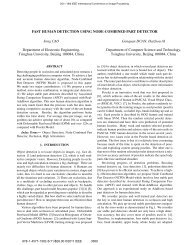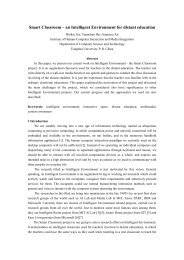Human Detection in Video over Large Viewpoint Changes
Human Detection in Video over Large Viewpoint Changes
Human Detection in Video over Large Viewpoint Changes
You also want an ePaper? Increase the reach of your titles
YUMPU automatically turns print PDFs into web optimized ePapers that Google loves.
<strong>Human</strong> <strong>Detection</strong> <strong>in</strong> <strong>Video</strong> <strong>over</strong> <strong>Large</strong> Viewpo<strong>in</strong>t <strong>Changes</strong> 1253<br />
CC<br />
MC<br />
Cluster<br />
(b)<br />
SC<br />
Classifier<br />
(a) (c) (d)<br />
Fig. 3: A perceptual cluster<strong>in</strong>g problem <strong>in</strong> (a)-(c) and a general EMC-Boost <strong>in</strong> (d)<br />
where CC, MC and SC are three components of EMC-Boost.<br />
4.1 Three components CC/MC/SC<br />
CC deals with a standard 2-class classification problem that can be solved by any<br />
boost<strong>in</strong>g algorithm. MC and SC deal with K clusters. We formulate the detectors<br />
of MC or SC as K strong classifiers, each of which is a l<strong>in</strong>ear comb<strong>in</strong>ation of<br />
weak learners H k (x) = ∑ t α kth kt (x), k = 1, · · · , K with a threshold θ k (default<br />
is 0). Note that the K classifiers H k (x), k = 1, · · · , K are same <strong>in</strong> MC with K<br />
different thresholds θ k , which means H 1 (x) = H 2 (x) = · · · = H k (x), but they<br />
are totally different <strong>in</strong> SC. We present MC and SC uniformly below.<br />
The score y ik of the i th sample belong<strong>in</strong>g to the k th clusters can be computed<br />
as y ik = H k (x i )−θ k . Therefore, the probability of x i belong<strong>in</strong>g to the k th cluster<br />
1<br />
is P ik (x) = . For aggregat<strong>in</strong>g all scores of one sample on K classifiers,<br />
1+e −y ik<br />
we formulate Noisy-OR like [18] [13] as<br />
P i (x) = 1 −<br />
K∏<br />
(1 − P ik (x i )). (9)<br />
k=1<br />
The cost function is def<strong>in</strong>ed as J = ∏ i P ti<br />
i (1 − P i) 1−ti where t i ∈ {0, 1} is<br />
the label of i th sample, which is equivalent to maximize the log-likelihood<br />
log J = ∑ i<br />
t i log P i + (1 − t i ) log(1 − P i ). (10)<br />
4.2 Learn<strong>in</strong>g algorithms of CC/MC/SC<br />
The learn<strong>in</strong>g algorithm of CC is directly Real Adaboost [17]. The learn<strong>in</strong>g algorithm<br />
of MC or SC is different from that of CC. MC and SC learn weak classifiers<br />
to maximize ∑ K ∑<br />
k i w kih kt (x i ) and ∑ i w kih kt (x i ) respectively at t th round of<br />
boost<strong>in</strong>g. Initially, the sample weights are: 1) For positives, w ki = 1 if x i ∈ k and<br />
w ki = 0 otherwise, where i denotes the i th sample and k denotes the k th cluster<br />
or classifier; 2) For all negatives we set w ki = 1/K. Follow<strong>in</strong>g the AnyBoost<br />
method [19], we set the sample weights as the derivative of the cost function



